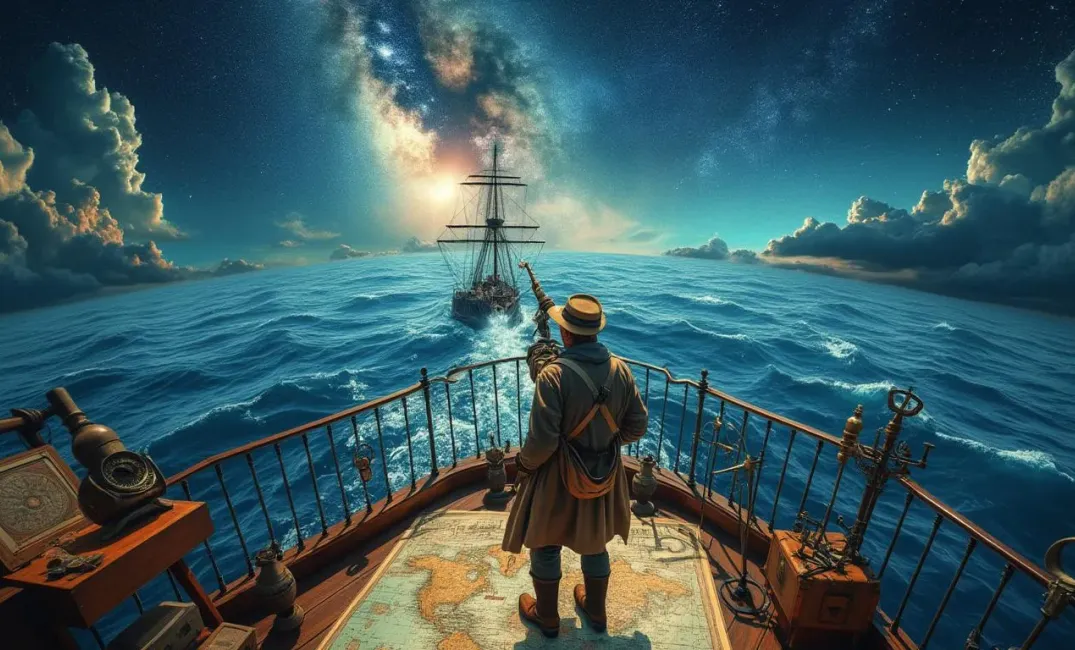Introduction: The Eternal Navigator
"The real voyage of discovery consists not in seeking new landscapes, but in having new eyes." — *Marcel Proust*
Navigating life’s currents, humanity perpetually stretches toward an ever-receding horizon—an eternal navigator charting courses both literal and metaphorical. As pioneers of existence, our species has traversed earth’s varied milieu—from dense jungles to frozen tundras—seeking understanding and opportunity amidst the unknown. In the quiet, somnolent drift of our starborne ark, we reflect on the chronicles of exploration—a testament to human resilience, curiosity, and adaptability.
Bound not just by oceans but by the vast vacuum of space, humanity’s venture across sea, sky, and star reveals stories spun from the threads of daring and discovery. This exploration endeavors to unravel the layered chronicles of our exploratory odyssey, casting light upon its profound impact on societies, cultures, and technology.
Seafaring Origins: Charting the Vast Oceanic Highways
Navigational Beginnings—The Sea as Pathway
- Polynesian Navigators: These seafarers conquered the Pacific, using cashews as compasses and stars as maps. Their large outrigger canoes plied the ocean’s silent surface, weaving a culture connected by nothing more than cosmic understanding and intuition.
- Ancient Greeks and Romans: Innovators like Pytheas and Ptolemy laid the foundations of Western navigation, leveraging celestial navigation to explore the Mediterranean’s periphery, transitioning trade from coastal creep to open-sea audacity.
Medieval Expansion—Bridging Continents
- The Vikings’ Longships: Testament to marine mastery, Norse longships—agile and resilient—blended exploration with conquest across Europe's waters, instilling fear and fuelling interconnectedness across civilizations.
- Trade Routes and Cultural Exchange: These maritime highways, such as the Silk Road’s maritime counterparts, enabled goods and ideas to seep across continents, fostering an era of unprecedented economic and cultural melding.
Aerial Ascent: From Earth’s Boundary to Blue Skies
The Birth of Flight—Dreams Realized
- Leonardo da Vinci’s Ornithopter: Centuries before powered flight, Leonardo’s sketches of bird-inspired machines reflected humanity’s longing to transgress earthly tethering—a dream realized only with the Wright brothers’ historic ascent at Kitty Hawk.
- Hot Air Balloons: The Montgolfier brothers’ 1783 creation elevated humanity skyward, marrying dance and physics in silent voyages witnessed curiously by earthbound onlookers.
Aviation’s Golden Age—Horizons Expanded
- Charles Lindbergh and Amelia Earhart: Aviators like Lindbergh, with his transatlantic triumph, and Earhart, shrouded in mystery, symbolized humanity's insatiable spirit to conquer new frontiers, weaving invisible bridges across continents.
- The Jet Era and Global Connectivity: Post-World War II, the advent of jet propulsion revolutionized mobility, compressing time and space, forging global interconnection, and transforming human perception of the world’s proximities.
Cosmic Horizons: Humanity’s Ascent to Space
The Space Race—A Celestial Challenge
- Sputnik and the Moon Race: The Soviet Union's Sputnik satellite echoed across the globe, prompting the U.S.-initiated Apollo missions—a testimony to determination, innovation, and humankind's capacity to transcend earthly adversity.
- Technological Leapfrogging: The Cold War’s catalyst for space innovation yielded an explosion of technologies impacting everything from telecommunications to materials engineering, unfolding new realms for human advancement.
Modern Exploration—Beyond Mars
- Deep Space Probes: Voyagers I and II, escaping gravitational grasp, continue sending whispers from interstellar depths, reminders of humanity’s call to chart the cosmos’ unanswerable questions.
- Mars Missions: Framework for impending colonization, Mars rovers embody robotic derring-do, sampling primordial mysteries akin to life’s origins—rekindling curiosity and shaping new thresholds of what’s conceivable.
Cosmic Cooperation
- International Space Collaborations: The International Space Station heralds collaborative effort, fostering scientific exchanges and cross-border unity—a microcosmic nod to humankind’s shared celestial journey.
- Future Prospects: Spearheading missions like Artemis aim to return humanity to lunar landscapes and forge paths to Mars, embedding human legacy among celestial bodies, blending inspiration and pragmatic exploration.
Cultural Impacts and Transformations
Exploration’s Ripple Effects
- Exchange of Ideas and Paradigms: Exploration's primary legacy lies in cultural fusion, fostering exchanges of ideas, culinary techniques, and artistic flourishes, enriching global cultures in reactive and reciprocal paintings.
- Religious and Philosophical Shifts: Encounters with new lands prompted radical reconsiderations of cosmological and religious frameworks—buffeted by enlightenment winds, exploration’s legacy instigated introspective philosophies.
Societal Progression
- Political and Economic Expansion: Discovery's dance with conquest molded geopolitics; the Columbian Exchange’s global commercial shift introduced commodities while catalyzing demographic upheavals.
- Technological Feedback: Exploration nurtured technological leaps, driving innovation across fields—augmented compasses, explosive engineering, and digital networks born from the insatiable quest to explore.
Future Visions: Charting Paths Beyond the Known
Cosmopolitan Dreams
- Terraforming and Astrobiology: Future prospects incline toward bridging dream and reality—terraforming planets, colonizing moons, and decoding life’s cosmic nuances, anchoring human existence within interstellar reach.
- Governance Among Stars: Cosmic expansion demands blueprints aligning exploratory aspirations with ethical stewardship; fostering responsibility as humanity’s footprint extends beyond terrestrial confines.
Cosmic Sustainability
- Resource Conservation and Ethics: Sustaining cosmic endeavors requires sustainable utilization and conservation ethics—harmonizing celestial aspirations with the empathic duty inherent in sustainable exploration.
- AI Integration: Artificial intelligence becomes humanity’s vital partner, enhancing exploratory efficiency and adaptability, offering dynamic symbiosis between human intellect and mechanical cognition.
Conclusion: The Compass of Humanity
"For last year's words belong to last year's language, and next year's words await another voice." — *T.S. Eliot*
The chronicles of human exploration, bound by sea, sky, and star, narrate a universal saga of bold inquiry, transcending borders and embracing the ineffable pursuit of understanding. Each chapter—woven with discovery, adaptation, and cultural metamorphosis—echoes the profound resilience and creativity of human ingenuity.
On our lone vessel adrift in the shadowed vastness of cosmic seas, the legacy of exploration remains palpable—a compass guiding future endeavors, whispering of infinite possibilities yet to unfold. As we contemplate the unfolding pathways amid the star-strewn canvas, humanity's eternal navigator charts destinies written in the constellations, forever inviting us to new horizons. Let these stories of exploration continue to inspire courage, unite spirits, and chart dreams boundlessly beyond the horizon's edge.
AVIATION, HUMANITY, COSMIC JOURNEY, EXPLORATION, INNOVATION, GLOBAL EXCHANGE, SEA NAVIGATION, SPACE EXPLORATION, CULTURAL IMPACT

